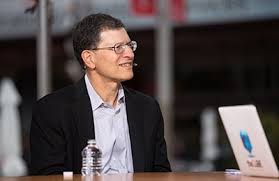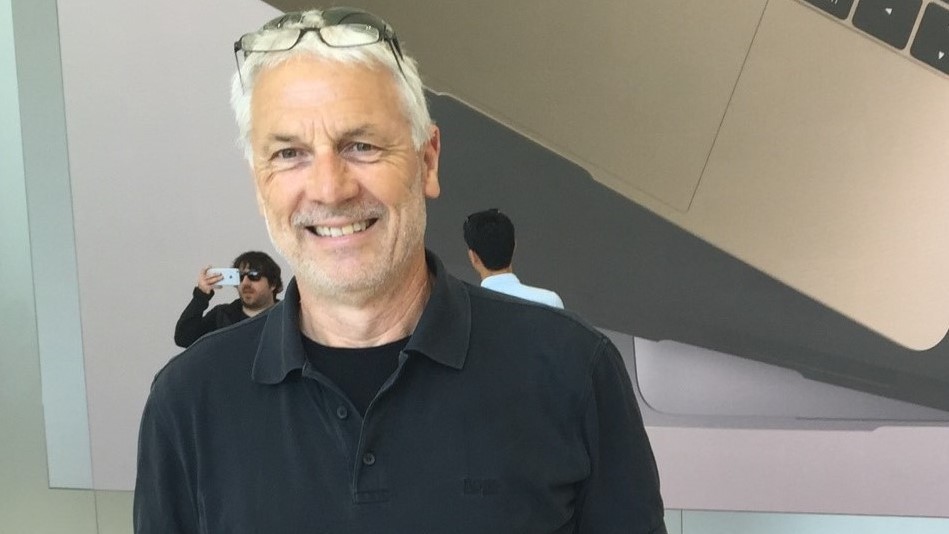dbms publishing - Oracle Database Technology
Interviews
Günther asks Andy #1 (July 2017)
Ich schreibe, weil ich nicht weiß, was ich denke,
bis ich lese, was ich sage.
Mary Flannery O' Connor
Günther asks Andy

Günther: Hallo Andy, thank you for your time. This is the first interview of a series of tech-talks for the DOAG-magazine. I am sure that the members of the German-, Swiss- and Austrian-user groups are excited to hear the Oracle Database inside track from you first hand.
Andy: My pleasure Günther! DOAG is one of the largest Oracle User Groups, and I always appreciate the opportunity to engage with the DOAG community leaders and members.
G: These days, databases are one of the most exiting technology areas in the IT-world. Databases are sexy again, yet here are so many different vendors active in the database area. How do you position your product – Oracle Database - at this vibrant time ?
A: I’d agree that the market is vibrant right now. I’d argue that this is partly because data has effectively become a new form of capital. Data has become an economic factor in the production of digital goods and services, which puts data and therefore data management, at front of mind for every organization today. As you know Günther, Oracle has established itself as the industry’s market leader by continually evolving our database technology to help customers address both their technical and business challenges. We’ve helped many customers through multiple computing generations: from mainframes and minis to client/server and the Internet with the minimum of disruption. Now, we’re helping customers on their journey to the Cloud by ensuring we have the best database technology for the cloud. We’ve made a huge investment in building the new Oracle Multitenant architecture into Oracle Database 12c, which is key to delivering database as a service on clouds (public or private) at lowest cost. We are offering a family of pay as you go data management services in the Oracle Cloud, that are fully compatible with customer’s on-prem environments. Plus we offer the only cloud with infrastructure optimized for database based on our engineered systems technology: Exadata Cloud Service and Exadata Cloud at Customer. These are truly unique offerings that other database and cloud vendors just cannot provide.
G: There are many new players in the database field right now. They come with new db-concepts, are fast in bringing new releases and get high interest in the developer community but also within big Oracle shops. Is the new Oracle Database release strategy a reaction to theses ‘New Kids on the block’ ?
A: Our reaction to new players in the database market is to make sure we continue to deliver the #1 data management technology to the market. For example, we have introduced our own NoSQL database for developers that like this concept plus we have assimilated the interesting concepts in these databases, namely JSON data and geo-sharding, into database 12c. As far as the new release model goes, we are moving to this model to improve customer experience with the database product. Annual database releases provide the opportunity for Oracle to roll out new features and requested customer enhancements in a more predictable and regular timeline. In other words, customers won’t have to wait multiple years for the next major database release to go into production. More importantly, the new Release Model is designed to improve the whole upgrade experience and patching process for our customers both on-prem and in Oracle Cloud.
G: For customers it is very important to understand the new release model. They must change their processes to adapt the new strategy. Can you please explain the basics of the new concept?
A:
Beginning with the next Database release (originally designated 12.2.0.2), new feature releases of the database product will be provided annually, and patchsets will no longer be released. To support both security-related fixes and high-priority non-security fixes to each annual release, quarterly Release Updates (RUs) will be provided each January, April, July and October. To allow customers to keep current on just security-related fixes once their feature environment becomes stable, quarterly Release Updates Revisions (RURs) will be provided each January, April, July and October for the most recent two (2) RUs. This RU and RUR process also replaced the legacy Patchset Update (PSU) and Bundle Patch process for 12.2.0.1 database software starting in July of 2017.
• RUs are proactive, highly tested bundles of critical fixes which enable customers to avoid known issues. They are specific to a particular annual release.
• RURs contain security and regression fixes to a RU that extend the RU’s lifetime up to two quarters. They are specific to a particular RU.
• The legacy terms ‘Patchset’, 'Patchset Update', and 'Database Bundle Patch' will no longer be meaningful for 12.2 database software.
This strategy allows a more conservative approach to maintenance while still getting fast access to critical security and proactive stabilization content. Customers can switch back and forth between RUs and RURs, whereas this is not possible with PSUs and BPs. Both RUs and RURs contain all security fixes, thus eliminating any 'security' versus 'stability' tradeoff.

G: What are the benefits of this new release strategy for the Oracle DB customers?
A: Yearly releases improve database agility and quality for our customers. Agility is improved by delivering new features to customers more quickly, eliminating multiple year waits for new functionality. Quality is improved by introducing smaller incremental changes rather than massive changes that are difficult to test and stabilize.
G: Oracle DB 12.2 was available first in the Oracle Cloud and a couple of months later available for all on premises customers. With a 12 month cycle such a delay makes not much sense. Will we see new releases for the db-cloud-services and for on premise at the same time ?
A: We expect the yearly releases to be available on the Cloud first. The cloud enables us to release software rapidly with the ability to swiftly address any issues on the cloud via automated, or fully managed, patching.
G: You say a RU (Release Update) is a fully tested bundle. Does this mean that you will enhance your quality control and testing-environment?
A: The Release Updates have an improved functional and stress testing compared to bundle patches. One major improvement is that we will be doing a much more extensive amount of stress testing of the release updates.
G: How does this new release strategy influence and change your development process and your developers work?
A: The yearly releases mean developers will be able to expose new functionality on a more frequent basis, and will have less pressure to add new features late in the release cycle to satisfy customer requests that can’t wait multiple years.
G: This brings me to a more general question. A new release has lots of new or enhanced features. In the old days a major release had around 400 to 600 new features. With the new strategy they will be lower per release but since you will bring a new release every year the sum of the features will be the same. How is the process from the idea of a new feature to the project itself? Who decides which idea is good enough to get an chance for implementation?
A: You are correct that the yearly releases will, in general, result in more incremental changes. In other words, customers can expect 100-200 new features rather than 400-600 new features on the previous multi-year releases. The database planning process starts with agreement on the focus areas for each release. Some focus areas such as high availability, performance, DW/analytics, and security are well established; others such as multitenancy have been introduced in more recent releases. Within each focus area, objectives are defined, and projects proposed. The selection of focus areas, and prioritization of projects is a joint exercise by release and product management, the focus area development leaders, and myself.
G: OK, I understand, but from whom are the ideas mostly influenced ? From competition, from science, from customer-requirements,…..?
A: Here at Oracle, I’m proud to say we have an incredibly talented team of development managers, product managers, architects and developers who continually innovate our data management technologies. And, we also listen very closely to what our customers ask for via multiple channels including MyOracle Support, Customer Advisory Boards, Oracle Technology Forums, and direct interaction with User Group communities such as DOAG, IOUG and many others.
G: Do you think it is useful that user-groups like DOAG/SOUG/AOUG and their members articulate their ideas for new and enhanced Oracle-DB features ?
A: Yes. There are multiple channels for user groups to provide enhancements ideas, including: 1. Oracle Community Ideas on OTN 2. Enhancement Requests via Oracle Support
G: We already talked a bit about the current “database renaissance”, mainly driven by the refocus to data but also by the new players in that market. What can Oracle do to keep the Oracle DB on the highest interest level especially for young IT-professionals and developers ?
A: Oracle started a global developer initiative in the last year, to increase developer awareness of Oracle products, as well as the Oracle Cloud, and it’s open and modern capabilities. One part of this initiative are Oracle Code events, happening in 20 cities around the world, that have so far reached over 8,100 developers in person. Developers also have access to $300 of free cloud credits when signing up with Oracle Cloud. For the database, we have driven quite a few initiatives as well the last year to make it easier and quicker for developers to get their hands on an Oracle Database. Last year we have made our database available as Docker images, which received great popularity, and we also decided to open source Docker build files for building such Oracle Database Docker images. We have also open sourced our Database App Development VM Vagrant scripts, which allow developers to build the popular Oracle Database App Development VirtualBox VM themselves. Both can be found on our Github page, github.com/oracle. With those initiatives we make it easier, as said, to get the Oracle Database into the hands of developers but that’s not all. We also have launched a new, fully open source Node.js driver for Oracle Database and we are happy to say that we recruited the main developer of the open source Python driver for Oracle. Both of those can also be found on our Github now.
G: It´s a matter of fact that Oracle DB drives thousands of applications today. But it is also a matter of fact that many IT- students learn database technology without the marketleader Oracle DB. They know Oracle by name but not by functionality. Why is Oracle DB not free for all universities or even schools ? I think this would be a small investment from Oracle side but with a really great positive effect in the future.
A: There are many offerings that that we provide that are free to students; people have just forgotten. Oracle Database Express Edition (XE) is our free Oracle Database edition for developers. There too you will see changes happening. We have decided to bring the full power of Oracle Database to Express Edition. XE’s originally intent was to be a small and quick to install Oracle Database when we released it back in 2005(!). We put a lot of attention on not making it too big which meant that we had to make some tradeoffs between the size and the features that we included. Obviously times have changed since then, especially internet speed and hardware capabilities. So we decided that going forward we will provide an Express Edition that includes all features that are relevant to developers. Other examples where we provide free services to our community are the $300 free credits for the Oracle Cloud, LiveSQL.oracle.com, and apex.oracle.com. Exadata Express Cloud Service is an example of a very low cost cloud service for developers. In addition we provide a lot of learning resources too, such as the Oracle Learning Library (OLL), the Oracle Massive Open Online Courses (MOOCs), the Oracle Dev Gym and AskTOM to give you some examples.
 G: Andy, what is in your eyes the next big thing in the database area ? Some people think the advent of “Non-Volatile Random-Access Memory” – NVRAMs – will change the database-technology as we know it… Do you agree and is this something Oracle work on ?
G: Andy, what is in your eyes the next big thing in the database area ? Some people think the advent of “Non-Volatile Random-Access Memory” – NVRAMs – will change the database-technology as we know it… Do you agree and is this something Oracle work on ?
A: I agree that NVRAM will be a huge disruption to storage and database markets. Oracle has been working with Intel for decades on chip optimizations for the Oracle Database, and implementing innovations in the Oracle Code to take advantage of advances of the Intel chipset and NVRAM. Specifically for NVRAM, we plan to transparently utilize NVRAM when it becomes commercially available. Other major transformations we are seeing include the evolution from data warehousing to big data, machine learning, and analytics of any type on any data source. Of course, we are also focused on the transition to cloud, ensuring our cloud infrastructure is optimized for data management workloads (online scalability, bursting, HA, security, etc). For the cloud, Oracle Database has been architected to provide core cloud advantages (elastic scaling, online bursting, agility and multitenancy), and we will continue to further our technological leadership on cloud architectures.
G: Thank you very much for your time Andy.
A: Thank you Günther!
Diese Interview wurde im Red Stack Magazin, dem Mitgliedermagazin der DOAG, SOUG und AOUG veröffentlicht. Red Stack ISBN 2366-7915.